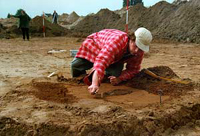Archaeology in Roermond
By Cathy Ni Cheallaigh
Roermond, ( population, 45,000), is situated in the south of the Netherlands, nestled between Belgium and Germany, at the confluence of the Roer and Maas rivers. Because of its geographical situation Roermond has always been a central point in European trading routes. The better known of her rivers, the Maas, stretches from northeast France to the North Sea. The Dutch geology is a pleasure to work with; sand metres deep and a minimum of rock.
As Roermond slowly developes into a tourist centre, it is continuously making way, in the name of progress, for shopping centres and apartment buildings. Some of these new city centre premises have underground parking facilities and as a result , more than ever before, the services of the archaeologists have been required. * Because Roermond has no city archaeologist, it relies mainly on two archaeological workgroups and, lately, the services of a hired archaeological company.
( *see "Where do we go from here ?)
Roermond is rich in finds.
On all of these excavation sites, medieval household items have resurfaced, some for the first time in over 700 years!
Pottery originating from over the borders found its way in large amounts to Roermond.
Styles named after towns around Cologne ( Köln ) in Germany such as Frechen, Pingsdorf, Siegburg and Cologne developed and between the 12th and 17th centuries they became rich pottery centres supplying the Netherlands with top quality workmanship.It may be interesting to see a selection of the discoveries found around Roermond:
Maasnielderweg, 1989 ( Roman graveyard )
As we know, the Romans left a wealthy trail throughout Europe. Roermond has been no exception. Many Roman artifacts can beseen in the city's museum. Sometimes, one only has to delve half a metre before one comes upon the Roman timeframe!
It is hard to believe that these beautiful glass objects have laid here, undisturbed, for almost 2000 years ! These are some of the treasures found at a depth of 60 centimeters on was to become a paved parking lot. Other delights of superior quality include glass bowls, bath oil bottles, tools, including a sheep shears and an abundance of pottery, some of which is stamped with the maker's name.( Otherwise known as grafitti )
Schuitenberg, 1988
(pots in situ):
These 10 large round storage pots, dating from around the 1300's and measuring approx 85 cms in height, were found during an excavation in
the Schuitenberg. The grey, thick- walled pots are made of Elmpt clay, ( Elmpt is a village 15 kms away over the Dutch-German border ).
Roersingel, 2000 ( Roerkade )
.
As Roermondenters a phase of becoming a tourist centre, it is continuously making way, in the in the name of progress, for shopping centres and apartment buildings.
The Roersingel is no exeption. One of the first discoveries of the new millenium was this this wrought iron cooking pot which was found in a tar pit.Musschenberg, 1997 prehistoric grave site + 1750 B.C.
In Roermond and the surrounding area ( 4,665 ha.) we have uncovered an abundance of stone tools dating back to prehistoric times. One of the most productive excavations carried out has been during the building of a new housing estate, the Musschenberg,where more than 150 bronze-age cremation urns were uncovered, proving that, this area was in use 2500 years ago.
With a trowel, the urn is carefully laid bare, measured and drawn. The urn is measured and drawn a second time in profile.
This process is called making a "coupe".
Finds are then given a code number.The urn is then wrapped in gauze. NB Notice the cremation fragments in the urn. These are then sieved to seperate the mud, possible bronze objects and cremation fragments. Each item is then coded and sent to the restoration department. During this process it is possible that the urns fall to pieces. Here a puzzle is put together with dissolvable glue, measured, drawn, described and worked into an inventory. A selection which is being prepared for shipping to the Provincial depot in Maastricht. Where do we go from here ?
As previously mentioned, Roermond has no city archaeologist, it relies mainly on two archaeological workgroups and, lately, the services of a hired archaeological company.
" De Gemeentelijke Archeologische Werkgroep", headed by the ciy council,deals more with the legalities and the infrastructure of each project. They meet four times a year. The second is workgroup " Rura ", which consists mainly of amateur archaeologists and historians. Its enthusiastic members provide a high quality range of services to assist with excavations in the city and surrounding area. They meet weekly to record and describe the finds.
Neither of these two groups may legally carry out an excavation without the supervision of an archaeologist. According to Dutch law, only those qualified may oversee archaeological projects. Not only do these companies deliver a technical ( archaeological ) report as part of their services, but provide a team headed by a qualified archaeologist. Thanks to the development of tighter building legislation here in Roermond, we may expect some interesting changes for archaeology and the understanding of the cultural heritage of this city. The archaeological department is found in the City Archives. In the archives a large range of books , reports and other reading material is accessible to the public.
Here also, objects found during digs are restored, drawn and cataloged before they are sent to the provincial depot in Maastricht.









